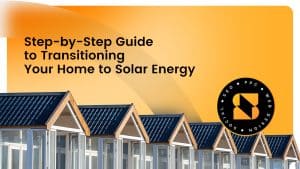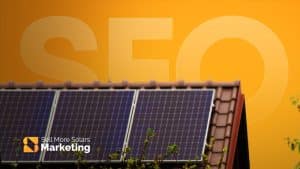Transitioning Your Home to Solar Energy is a great way to reduce your carbon footprint, lower electricity bills, and increase your home’s value. However, the process can seem complex if you don’t know where to start. This home solar installation guide will walk you through the key steps to successfully make the switch.
Why Transitioning Your Home to Solar Energy is a Smart Choice
Transitioning Your Home to Solar Energy is a smart financial and environmental decision. A typical 5 kW solar system can cover 70–100% of a home’s electricity needs, saving homeowners $20,000–$60,000 over 25 years. The 30% federal tax credit and state incentives further reduce costs, with an average payback period of 6–10 years. Solar panels also increase home value by 4.1% (Zillow) and prevent about 6.3 metric tons of CO₂ emissions annually, equivalent to planting 100+ trees. With 4 million U.S. homes already using solar and storage solutions like the Tesla Powerwall providing backup power, solar energy is a reliable, cost-effective, and sustainable choice.
Step 1: Assess Your Home’s Solar Potential
Before investing in solar panels, it’s important to determine if your home is suitable for solar energy. Consider the following factors:
- Sunlight Exposure: Homes with south-facing roofs receive the most sunlight, but east- and west-facing roofs can also be viable.
- Roof Condition: Ensure your roof is in good shape, as solar panels last for 25+ years. If your roof needs repairs, it’s best to address them before installation.
- Shading Issues: Trees, buildings, or other obstructions can reduce solar efficiency. Consider trimming trees or using solar panel placement strategies to maximize sunlight exposure.
- Local Climate: While solar panels work in various climates, locations with abundant sunlight yield the best results.
Step 2: Determine Your Energy Needs
Analyzing your energy consumption is crucial in deciding how many solar panels you need. Review your electricity bills from the past year to understand your energy usage patterns. Your electricity bill provides data on your monthly and annual energy consumption, measured in kilowatt-hours (kWh). This information helps estimate the size of the solar system required to meet your household’s energy demands.
A few key factors to consider when determining your energy needs include:
- Peak Energy Usage: Identify months when your energy consumption is highest. This is particularly important if you live in areas with extreme summer or winter temperatures requiring air conditioning or heating.
- Future Energy Needs: If you plan to purchase electric vehicles, add appliances, or expand your home, factor in the additional electricity demand.
- Energy Efficiency Improvements: Consider making energy-efficient upgrades, such as LED lighting, smart thermostats, or improved insulation, to reduce overall electricity usage before installing solar panels.
- Grid-Tied vs. Off-Grid Systems: If you choose a grid-tied system, you may need fewer panels since you can draw from the grid when needed. Off-grid systems require more panels and battery storage to ensure power availability at all times.
By carefully analyzing your energy needs, you can ensure that your solar system is sized appropriately to maximize efficiency and cost savings.
Step 3: Research Solar Panel Options
There are various types of solar panels available, each with its own benefits and drawbacks. The right choice depends on your budget, available roof space, and energy needs. Below are the three main types of solar panels to consider:
- Monocrystalline Panels: These are made from a single crystal structure, making them the most efficient type of solar panel. They offer higher energy output and better performance in low-light conditions. Monocrystalline panels also have a sleek black appearance, making them visually appealing. However, they tend to be more expensive than other options.
- Polycrystalline Panels: These panels are made from multiple silicon fragments melted together. While they are less efficient than monocrystalline panels, they are more affordable. Polycrystalline panels have a blue hue and require slightly more space to generate the same amount of electricity as monocrystalline panels. They are a good option for homeowners looking for a balance between cost and efficiency.
- Thin-Film Panels: These are lightweight, flexible panels that can be installed on various surfaces, including unconventional roof shapes. They are less efficient than crystalline panels and require more space to generate the same amount of energy. However, they work well in cloudy conditions and high-temperature environments. Thin-film panels are ideal for large-scale installations where space is not a major concern.
When choosing the best solar panel type, consider factors such as:
- Available Roof Space: Monocrystalline panels are ideal for smaller roofs due to their high efficiency, while thin-film panels work better for expansive spaces.
- Budget: If you have a limited budget, polycrystalline panels may be the best option.
- Climate Conditions: If you live in an area with frequent overcast weather, thin-film panels may perform better than crystalline options.
By understanding the differences between these solar panel types, you can make an informed decision that aligns with your energy needs and financial goals.
Step 4: Choose the Right Solar Installer
Selecting a reputable solar installer is important to a successful transition. Choosing the right professional ensures your system is installed safely, efficiently, and according to regulations.
Look for installers with:
Proper Licensing and Certification: Check for certifications such as NABCEP (North American Board of Certified Energy Practitioners). A certified installer ensures quality workmanship and compliance with industry standards.
Experience and Reviews: Research multiple companies and read customer reviews to gauge their reliability. Request references from past clients to learn about their experiences. An experienced installer will be able to handle unforeseen challenges and provide expert recommendations.
Comprehensive Warranties: A good installer offers warranties on both equipment and workmanship. Solar panels typically come with a 20- to 25-year warranty, while installation warranties may vary. Ensure you understand what is covered and for how long.
Transparent Pricing: Request quotes from multiple installers and compare pricing, equipment, and services included. Be wary of hidden fees or overly aggressive sales tactics. A trustworthy installer will provide a clear breakdown of costs and financing options.
Step 5: Understand Solar Incentives and Financing Options
Going solar can be a significant investment, but incentives and financing options make it more affordable. Understanding your options can help maximize savings and reduce upfront costs:
Federal Solar Tax Credit: The ITC (Investment Tax Credit) allows homeowners to deduct a percentage of their solar system cost from their federal taxes. This incentive can significantly lower your overall investment in solar energy.
State and Local Incentives: Many states and local governments offer additional incentives such as rebates, tax credits, and net metering programs. Net metering allows you to earn credits for excess energy your system generates, further reducing your electricity costs.
Financing Options: Choose between different financing methods based on your budget and long-term goals:
Cash Purchase: Paying upfront offers the highest savings over time and provides full ownership of the system.
Solar Loans: These allow you to finance the system with monthly payments, often with little to no upfront costs. Many loans offer low interest rates and terms designed for solar buyers.
Leases and Power Purchase Agreements (PPAs): With a lease or PPA, you don’t own the system but pay a fixed monthly fee or a rate for the electricity generated. These options provide lower initial costs but may yield fewer long-term savings.
Step 6: Obtain Permits and Approvals
Before installation begins, you need to obtain the necessary permits. Your solar installer usually handles this step, but it’s good to be informed about the requirements in your area. Permits may include:
- Building permits
- Electrical permits
- Utility interconnection agreements
Approval from your local government and utility company is necessary before installation can start.
Step 7: Install the Solar Panels
The actual solar panel installation steps include:
- Mounting the Racking System: Installers secure the racking system to your roof, ensuring it can support the weight of the panels.
- Placing the Solar Panels: Panels are mounted onto the racking system and secured in place.
- Wiring and Connecting the System: Wiring connects the panels to an inverter, which converts solar energy into usable electricity.
- Connecting to the Electrical Grid: If using a grid-tied system, the system is connected to your utility company for net metering.
- Testing the System: The installer ensures everything is properly connected and functional.
Step 8: Inspection and System Activation
Once the installation is complete, a final inspection is required before activating the system. A local inspector will verify that the system complies with all safety and building codes. After approval, your utility company will grant permission to operate (PTO), and your solar system will be officially switched on.
Step 9: Monitor and Maintain Your System
While solar panels require minimal maintenance, regular monitoring ensures optimal performance. Most systems come with online monitoring tools that track energy production. To keep your system running efficiently:
- Clean panels occasionally to remove dirt and debris.
- Check for shading changes due to tree growth.
- Schedule periodic inspections to ensure all components function properly.
Step 10: Enjoy the Benefits of Solar Energy
Once your solar system is fully operational, you’ll start seeing the benefits, including:
Lower Electricity Bills: One of the most immediate advantages of solar energy is the reduction in your monthly electricity costs. Depending on the size of your system and your energy consumption, you may significantly lower or even eliminate your utility bills. Any excess energy your panels generate can often be credited back through net metering programs, further increasing your savings.
Energy Independence: By producing your own electricity, you reduce reliance on the grid and protect yourself from fluctuating energy prices. This stability is especially beneficial in regions where energy costs are high or where power outages are common. If you have a solar battery storage system, you can store excess energy for use at night or during outages, increasing your independence even further.
Environmental Benefits: Solar energy is a clean, renewable source of power that helps reduce your carbon footprint. Unlike fossil fuels, solar panels generate electricity without producing harmful emissions, reducing greenhouse gases and contributing to a healthier planet. By switching to solar, you are playing an active role in combating climate change and promoting sustainability.
Increased Property Value: Homes equipped with solar energy systems often have higher resale values. Buyers are increasingly looking for energy-efficient homes, and a solar-powered property can be a valuable selling point. Studies show that homes with solar panels tend to sell faster and at higher prices compared to non-solar homes.
Minimal Maintenance: Once installed, solar panels require very little maintenance. Occasional cleaning to remove dust, leaves, or debris and an annual inspection to ensure everything is functioning properly are typically all that’s needed. Most systems come with long-term warranties, offering peace of mind for years to come.
Long-Term Savings: While the upfront cost of solar installation can be significant, the long-term financial benefits make it a worthwhile investment. With rising electricity rates, your savings will only increase over time, allowing you to allocate your finances to other important areas.
Final Thoughts
Transitioning to solar energy may seem like a complex process, but by following this home solar installation guide, you can confidently make the switch. Understanding the solar panel installation steps and working with a reliable installer ensures a smooth and successful transition. With the right planning and execution, your home will benefit from clean, renewable energy for years to come.









